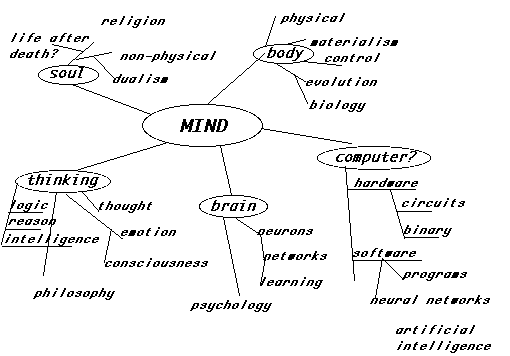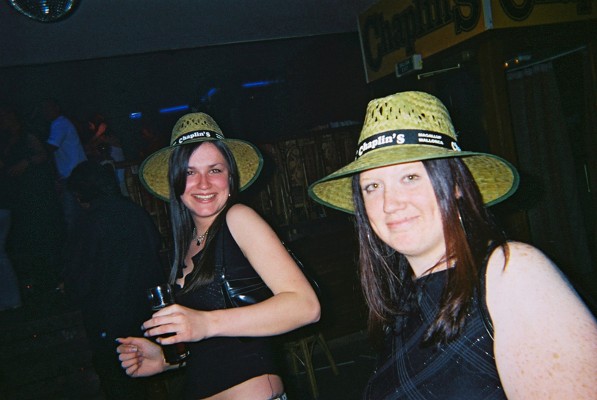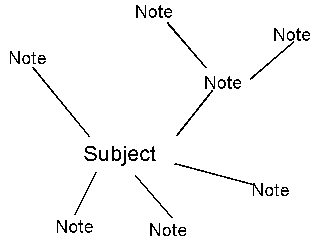
|
The ABC Study Guide, University education in plain English alphabetically indexed. Click here to go to the main index |

|
|
Generating Ideas
|
|||
|
Creative thinking is untidy
Brainstorming Spidergrams and Mind Maps Relating ideas Using Cards to Generate Project Ideas |

|
Click the picture
to go to research fairy land |

Note the three-stage structure: MIND connects with SOUL, BODY, THINKING, BRAIN, COMPUTER, and each of these concepts relate to several other concepts. This is not the sort of exercise where you have to find the "correct" way to do it. Each person's mind-maps of a given concept, like MIND, will be different. Mindmapping is a way to get clear on what you think.
Relating ideas
In the examples on this page, what one is doing is relating ideas.
This will be more productive if you think about whose ideas you are
intending to relate. In the
mind map
example, the ideas are clearly those of the person making the map. Academic
work, however, is carried out in the context of ideas
that have been developed by many people, so one often needs to analyse and
relate the ideas of a particular author. To do this, you will need to
identify the concepts used by the author and examine how you think they are
related within his or her work.
Authors (theorists) usually have central concepts (key concepts) that guide and structure their work. Relating the author's ideas becomes more meaningful if one attempts to identify the key concepts, and to see how the other concepts are understood in the light of them.
Creativity Card Games
From
Ashman, S. and George, A. 1982
Study and Learn
Using cards to generate project ideas
Get a set of file cards or cut up some sheets of file paper and write
down each component topic of the field you are interested in, one per card.
Put in more, rather than less, including topics which you think are almost
marginal.
Now on a clear table top spread out all the cards. Arrange them either
in sequence in rows from left to right or, better still, try to work out
a scheme starting from the centre of the table and creating a branching
pattern according to priority and linkage.
See what new ideas are generated by changing the centre card of the
pattern. Also think hard about the type of links you might make between
topics. Begin to define what's in the project and what you should
exclude.
Be prepared to brainstorm with unlikely
connections. By forcing connections between very different ideas, you are
tracing new pathways across the subject area. At the least, you will
reassure yourself of the relative importance and interconnection of your
main study areas. You may also stumble across a new perspective which will
provide you with the excitement and motivation to set off on a project.
You could just play around with the cards and put them into a
workable sequence
Surprise connections
Take a set of key ideas from the general area in which your topic is
to be located and try matching them in turn to a randomly selected series
of words - Perhaps you could just collect the random words by letting a
dictionary fall open
For example:
| Key ideas | Random words |
|---|---|
|
Office management
ways of improving social and tachnical |
colour,
electricity, arguments, junctions, helping, boxes |
You should be prepared to brainstorm with the most unlikely connections. Ask yourself what links you could make, for example, between office management and colour. Perhaps this would lead you into considering environmental influences, including colour schemes, on office workers and the quality or colour of their office experience. Perhaps colour might suggest political colour, which might lead on to social structure and organisation.
Creativity Groups
Groups of people working together can stimulate one another's ideas. This
is one reason why
dialogue
is so important academically.
For groups to be creative we need to take an interest in one another's projects and to be sympathetic. A friendly group of people working on different projects can generate ideas in the process of just explaining to one another what they are doing and discussing it.
Generating ideas about new projects
A group of students are working on different projects and have explained them to one another. They may be able continue the conversation creatively by exploring the keywords in their projects.
They are writing about surveillance, about madness, about community, about the imagination, about authority and power, about total institutions, about political perspectives and about science, philosophy and theology - but that all of them have only recently chosen or received their topic and know little about it.
It should help to develop their ideas if they explore what each word means to each of them, and what they think it might mean in the context of their project. One way to do this would be to brainstorm similar words, related words and opposite words.
The group played word-ball game. In this, we sit in a circle and throw words at one another. So, the starter says a word (for example: Imagination) and throws it to someone else by saying his or her name (for example: "Imagination - Jayne"). Jayne catches it by saying what she heard, saying another word, and throws it to someone else: "Imagination - Creative - Caroline", and so on. After a while, the group stop and discuss the words.
Here are the results of an actual group
| WORDS | DISCUSSION |
|---|---|
|
Imagination
Creative Individual Free-thinking Original Unique Boring Uncaptivating Interesting Not lively Desire |
The words are mostly similar words or opposite words to the first word.
We wondered if we should let our imagination be more free-thinking. For example, dreams are not the same, but many people who write about the imagination discuss dreams. See, for example, Mary Shelley, William Morris and Sigmund Freud Some people worried about saying the "right" word. There is no right word - just say anything. The game helps people get to know the names of the other people in the group. To help, we had a list of everyone's names. |
| WORDS | DISCUSSION |
|---|---|
|
Community
Socialise Isolation Crowd Close-knit Union Group Solidarity Oppression Liberation Constructed Freedom Slavery |
The words seem to break free at oppression. We asked what the link in the
person's mind was. She said
"I think of society as about oppression as I am a marxist" We discussed Raymond Williams comment that community is always a nice, cuddly, concept and that nasty words, like oppression, only get connected to words like state and society. Would this be true of the use of community by Adolph Hitler? |
| WORDS | DISCUSSION |
|---|---|
|
Childhood
Children Single parent Coping |
The words are very closely linked to one theme. We broadened the issues by
discussing how they might relate to other themes. Some people argued that
the world of the child is a world of the
imagination and that grown ups use
rules and regulations to control this. This is an exercise of
power
that stifles imagination. We discussed the relationship (if any) between
madness and imagination.
We discussed the family as an institution and whether it was ever a total institution. As a counterpoint to the idea of the family as control, we discussed the possibility of power being used to develop autonomy. We could have discussed (but did not) whether the family is a community, what political perspectives use childhood and the family as a model for the relation between ruler and ruled and and what the differences are between theological, philosophical and scientific ideas about childhood. |
The following game is played according to the selfish-student-rule. This is
that each student tries to divert the game to his or her theme. It is a way
of exploring the inter-relationship between themes. Something that had
already been done in the discussion on childhood Some points at which a student diverted
the word are marked with an asterisk (*)
| WORDS | DISCUSSION |
|---|---|
|
Authority
Power Control Community Society Individual Durkheim * Deviance Crime Surveillance * Police Handcuff |
The discussion of this was brief as we had spent a long time on linking
issues under childhood and did not have much time left.
We discussed the link between authority and power and childhood and imagination This led on to a discussion of Michel Foucault and the way his theories analyse knowledge as power and the way in which many of the themes come together in his work. Following on from the childhood link to stress, we could have discussed (but did not), John Watson's argument that fear is as an important a basic motive as love and how he and Rosalie Rayner used this to control children. |
| Our housekeeping session |
|---|
|
We had a session tidying up the word-game results by considering what
aspects of our subjects had not been discussed, or not been discussed
enough. This is the list we will be working on:
Dreams and their relationship to madness and hallucinations.
|

So what have Lisa and Jenny got to do with anything? Please send ideas about this or any other aspect of generating ideas to Andrew Roberts |
|---|
 Study
Link
Study
Link
 Andrew Roberts' web Study Guide
Andrew Roberts' web Study Guide
 Top of
Page
Top of
Page
 Take a Break - Read a Poem
Take a Break - Read a Poem






















